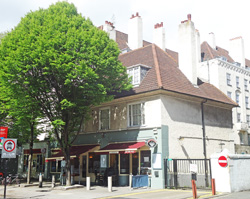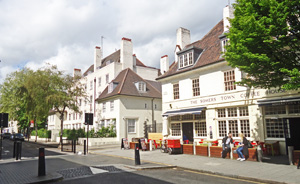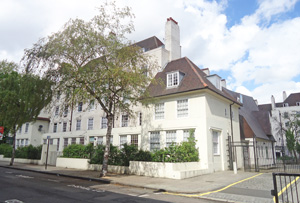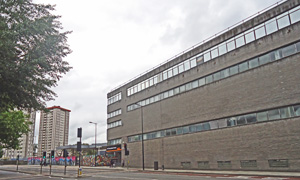St Pancras School for Mothers
1 Ampthill Square, NW1 2BX
Medical
dates:
Medical
character:
Infant Welfare Centre
At the turn of the 20th century,
recruitment to the army to fight the Boer War (1889-1902) had brought
attention to the fact that half the potential recruits were physically
unfit and therefore could not be enlisted. To improve the health
of the urban population, efforts to improve the nutrition and
well-being of babies and children were initiated by several voluntary
organisations.
One of the most deprived and overcrowded areas in London at this time was Somers Town, beyond the railway termini of Kings Cross and St Pancras, where people lived in filthy and appalling conditions in some of the worst housing in the city.
In 1904 the infant mortality rate for the area was high - 152 deaths per 1,000 live births (15%) - and Dr John F.J. Sykes, the Medical Officer of Health for the Borough of St Pancras, had begun a campaign to improve the health of mothers (he coined the phrase 'mothercraft'), encouraging them to breastfeed their babies instead of using bottled milk, and discouraging them from early weaning.
A meeting, organised by Dr Sykes and chaired by Dr Howard Barrett, was held on 1st May 1907 to discuss the subject of infant mortality in the Borough (by 1907 the rate had dropped to 114 per 1,000 live births). During the meeting, Mrs W.E. Gordon described the Chelsea dinners provided for nursing mothers, while Mrs Alys Russell (first wife of the philosopher Betrand Russell) spoke of the School for Mothers in Ghent, Belgium.
It was decided, as an experiment, to combine features of both schemes and establish a School for Mothers to provide mothers with advice (rather than treatment) as to the proper care of their babies and, at the same time, enable them to receive a wholesome meal.
The St Pancras Mothers' and Infants' Society was established as a charity, and the West London Mission Hall at Nos. 6-7 Chalton Street, an old Methodist Hall off the Euston Road, was leased.
The St Pancras School for Mothers was officially opened on 1st July 1907 by Lord Robert Cecil. The premises consisted of a large well-lit ground floor and basement. The words Mothers' and Babies' Welcome were painted across the front of the building (it was called the 'Welcome' to avoid intimidating local women with the word 'School').
The work of the School was multi-fold. Most women came because their infants were failing to thrive. On their first attendance, the baby was weighed, and then sent upstairs to be examined by a doctor. The health of the mothers was seen as central to the survival and health of their infants, and thus the nutrition of mothers during pregnancy and nursing was most important. Except on Sundays, dinners were provided for underfed nursing and expectant mothers (for two to three months before the birth) at a cost of one penny a meal. If the baby was then breast-fed, mothers were allowed to receive free dinners for nine months. Classes on hygiene were held and a provident maternity club established. Home visits were also provided.
The Honorary Medical Officer attended on two afternoons a week to examine the babies and their mothers, and to advise on matters of feeding, clothing and management of the baby. Babies were weighed periodically and records kept of their progress.
Mothers who came regularly could join a club, paying one penny a fortnight. Non-nursing mothers were also encouraged to attend and assisted in procuring pure milk for the feeding of their infants.
Ten months after opening, some 218 babies under 12 months of age had been brought to the School (once a baby was one year old, it was no longer eligible to attend). Some 1,933 dinners had been provided during the period 25th June 1907 to 31st March 1908. The average cost of the actual food was about two pennies, of which the mother paid half. If she could not afford this, private individuals or charitable associations paid; the remainder were provided free by the St Pancras Mothers' and Infant's Society.
When originally established, it had been reckoned that £300 a year would be sufficient to run the School. However, after 10 months, £269 had already been spent on running costs. Expenses, such as weighing machines, oil cloth, furniture and household repairs, had not been accounted for.
The School closed briefly before opening on 16th December 1908 at No. 37 Chalton Street.
The Society applied to the Board of Education for grants in aid of classes to teach the women how to cook inexpensive nourishing meals for themselves and their families, and how to cut out and sew garments for their babies.
Although very small amounts of grant money were given, the application drew attention to the work provided by the School and the need for more official support. By 1909 the School was working together with the Health Department of the Borough Council, although it remained supported by charitable subscriptions.
The cooking classes soon proved to be useless for the women who needed them most - mainly because they did not possess the equipment used in the class, or the recipes were too complicated and the ingredients too expensive. The Committee decided it would be better to teach each women in her own home, using what utensils and cooking facilities she had, and what ingredients she could afford.
Fathers' Evening Conferences were held once a week in the winter evenings by the Medical Officer of Health, who gave 30-minute lectures on such subjects as 'Milk', 'Sleep', 'The Father's Duty to the Unborn Child', 'Should the Mother go out to Work?', etc. The lecture was followed by a discussion; coffee was handed round and smoking was allowed.
By 1911 the School had moved to a large detached house with a garden at No. 1, Ampthill Square, on the corner of Hampstead Road. The rent, rates and taxes were paid by the Borough Council. In addition to its usual work, the School had a day nursery for infants needing observation and special attention. Dinners for needy expectant and nursing mothers (at a charge of 4d (2p) a meal), as well as young children, continued to be provided. There was also a dental clinic for mothers and for children aged between 2 and 5 years. (In 1920 a massage clinic for children was added).
In July 1911 a second St Pancras School for Mothers opened in Kentish Town to serve the north part of the Borough.
In 1914 the Board of Education and the Local Government Board extended the amount of grant money available. When war broke out in that year, the welfare of women and children became a matter of general concern.
In 1918 a branch of the School opened on a part-time basis at its original location in the West London Mission Hall at No. 6 Chalton Street. The rent for the premises was paid by the Borough Council.
The Notification of Births Extension Act, 1915, and the Maternity and Child Welfare Act, 1918, together with the establishment of a Ministry of Health in 1919, enabled local authorities to set up extensive schemes to prevent mortality and morbidity in infancy and early childhood. The era of municipal Infant Welfare Centres was born.
By 1920 the number of clinic sessions at the School had increased. Massage clinics were established at both sites, but these were suspended on 30th June 1926.
By 1926 the Borough had 11 centres, each managed by a voluntary committee, which raised funds in addition to those provided by the Borough Council.
The School continued to be run by the Borough Council until it closed in the early 1960s.
One of the most deprived and overcrowded areas in London at this time was Somers Town, beyond the railway termini of Kings Cross and St Pancras, where people lived in filthy and appalling conditions in some of the worst housing in the city.
In 1904 the infant mortality rate for the area was high - 152 deaths per 1,000 live births (15%) - and Dr John F.J. Sykes, the Medical Officer of Health for the Borough of St Pancras, had begun a campaign to improve the health of mothers (he coined the phrase 'mothercraft'), encouraging them to breastfeed their babies instead of using bottled milk, and discouraging them from early weaning.
A meeting, organised by Dr Sykes and chaired by Dr Howard Barrett, was held on 1st May 1907 to discuss the subject of infant mortality in the Borough (by 1907 the rate had dropped to 114 per 1,000 live births). During the meeting, Mrs W.E. Gordon described the Chelsea dinners provided for nursing mothers, while Mrs Alys Russell (first wife of the philosopher Betrand Russell) spoke of the School for Mothers in Ghent, Belgium.
It was decided, as an experiment, to combine features of both schemes and establish a School for Mothers to provide mothers with advice (rather than treatment) as to the proper care of their babies and, at the same time, enable them to receive a wholesome meal.
The St Pancras Mothers' and Infants' Society was established as a charity, and the West London Mission Hall at Nos. 6-7 Chalton Street, an old Methodist Hall off the Euston Road, was leased.
The St Pancras School for Mothers was officially opened on 1st July 1907 by Lord Robert Cecil. The premises consisted of a large well-lit ground floor and basement. The words Mothers' and Babies' Welcome were painted across the front of the building (it was called the 'Welcome' to avoid intimidating local women with the word 'School').
The work of the School was multi-fold. Most women came because their infants were failing to thrive. On their first attendance, the baby was weighed, and then sent upstairs to be examined by a doctor. The health of the mothers was seen as central to the survival and health of their infants, and thus the nutrition of mothers during pregnancy and nursing was most important. Except on Sundays, dinners were provided for underfed nursing and expectant mothers (for two to three months before the birth) at a cost of one penny a meal. If the baby was then breast-fed, mothers were allowed to receive free dinners for nine months. Classes on hygiene were held and a provident maternity club established. Home visits were also provided.
The Honorary Medical Officer attended on two afternoons a week to examine the babies and their mothers, and to advise on matters of feeding, clothing and management of the baby. Babies were weighed periodically and records kept of their progress.
Mothers who came regularly could join a club, paying one penny a fortnight. Non-nursing mothers were also encouraged to attend and assisted in procuring pure milk for the feeding of their infants.
Ten months after opening, some 218 babies under 12 months of age had been brought to the School (once a baby was one year old, it was no longer eligible to attend). Some 1,933 dinners had been provided during the period 25th June 1907 to 31st March 1908. The average cost of the actual food was about two pennies, of which the mother paid half. If she could not afford this, private individuals or charitable associations paid; the remainder were provided free by the St Pancras Mothers' and Infant's Society.
When originally established, it had been reckoned that £300 a year would be sufficient to run the School. However, after 10 months, £269 had already been spent on running costs. Expenses, such as weighing machines, oil cloth, furniture and household repairs, had not been accounted for.
The School closed briefly before opening on 16th December 1908 at No. 37 Chalton Street.
The Society applied to the Board of Education for grants in aid of classes to teach the women how to cook inexpensive nourishing meals for themselves and their families, and how to cut out and sew garments for their babies.
Although very small amounts of grant money were given, the application drew attention to the work provided by the School and the need for more official support. By 1909 the School was working together with the Health Department of the Borough Council, although it remained supported by charitable subscriptions.
The cooking classes soon proved to be useless for the women who needed them most - mainly because they did not possess the equipment used in the class, or the recipes were too complicated and the ingredients too expensive. The Committee decided it would be better to teach each women in her own home, using what utensils and cooking facilities she had, and what ingredients she could afford.
Fathers' Evening Conferences were held once a week in the winter evenings by the Medical Officer of Health, who gave 30-minute lectures on such subjects as 'Milk', 'Sleep', 'The Father's Duty to the Unborn Child', 'Should the Mother go out to Work?', etc. The lecture was followed by a discussion; coffee was handed round and smoking was allowed.
By 1911 the School had moved to a large detached house with a garden at No. 1, Ampthill Square, on the corner of Hampstead Road. The rent, rates and taxes were paid by the Borough Council. In addition to its usual work, the School had a day nursery for infants needing observation and special attention. Dinners for needy expectant and nursing mothers (at a charge of 4d (2p) a meal), as well as young children, continued to be provided. There was also a dental clinic for mothers and for children aged between 2 and 5 years. (In 1920 a massage clinic for children was added).
In July 1911 a second St Pancras School for Mothers opened in Kentish Town to serve the north part of the Borough.
In 1914 the Board of Education and the Local Government Board extended the amount of grant money available. When war broke out in that year, the welfare of women and children became a matter of general concern.
In 1918 a branch of the School opened on a part-time basis at its original location in the West London Mission Hall at No. 6 Chalton Street. The rent for the premises was paid by the Borough Council.
The Notification of Births Extension Act, 1915, and the Maternity and Child Welfare Act, 1918, together with the establishment of a Ministry of Health in 1919, enabled local authorities to set up extensive schemes to prevent mortality and morbidity in infancy and early childhood. The era of municipal Infant Welfare Centres was born.
By 1920 the number of clinic sessions at the School had increased. Massage clinics were established at both sites, but these were suspended on 30th June 1926.
By 1926 the Borough had 11 centres, each managed by a voluntary committee, which raised funds in addition to those provided by the Borough Council.
The School continued to be run by the Borough Council until it closed in the early 1960s.
Present status (May 2015)
Somers Town was redeveloped during the late 1920s and early 1930s, and the street numbering changed. Nos. 6 and 7 Chalton Street are now Nos. 16 and 18. The site of No. 37 Chalton Street is now occupied by the Ossulston Estate.
However, the Ampthill Square site was erased by the building of the Euston station approaches.

The original site of the School at Nos. 6-7 Chalton Street is now numbered 16-18 and occupied by the Albertini Cafe.

The second site, on the corner of Chalton Street and Chapel Street, is now part of the Ossulston Estate. Chapel Street was obliterated in the redevelopment. The site of the School is just north of the Somers Town Coffee House.

The site of the School is occupied by an apartment block.

The passage on the right of the image follows the line of the former Chapel Street.

The site of the gardens of No. 1 Ampthill Square is now occupied by a former office and warehouse building at No. 140 Hampstead Road.

In 2014 the building became the temporary home of the Bartlett School of Architecture, part of University College London.

The London Borough of Camden purchased land beside and including Ampthill Square in the early 1960s. The Ampthill Square Estate opened in 1965. Two of the 'Three Sisters' - colour-coded tower blocks - of the Estate at Mornington Crescent can be seen on the left of the image.
(Author unstated) 1907 A School for Mothers. New York Times, 7th July.
(Author unstated) 1908 St. Pancras School for Mothers. British Medical Journal, 1 (2476), 1462.
(Author unstated) 1909 Medical News. British Medical Journal, 2nd January, 46.
(Author unstated) 1909 The prevention of infant mortality. British Medical Journal 2 (2489), 775.
(Author unstated) 1910 The feeding of mothers. The Midwife. British Journal of Nursing Supplement, 18th June, 503.
(Author unstated) 1910 Outside the gates. British Journal of Nursing, 3rd September, 91.
(Author unstated) 1917 The St. Pancras School for Mothers. Common Cause, 5th January, 3.
Campbell J 1932 Maternity and child welfare services in their relation to public health. British Medical Journal 2 (3751), 960-963.
Davies S 2014 The St Pancras School for Mothers. London, Wellcome Library.
Geffen DH 1952 Report of the Medical Officer of Health. London, St Pancras, p. 16.
Hogikyan E 2014 "The hope of the future lies in their instruction"; Health Education in the British Infant Welfare Movement, 1900-1914. University of Michigan, B.A. thesis.
'Hygeia' 1907 Our babies. Otago Witness, 27th November, 71.
Lidgett Bunting DE 1910 Schools for Mothers. In: Kelynack TN (ed) Infancy. London, Robert Culley, pp. 67-76.
Ross E 1993 Love and Toil: Motherhood in Outcast London, 1870-1918. Oxford University Press.
Shadick Higgins T 1919 Annual Report of the Medical Officer of Health. London, St Pancras, p. 58.
Sowden G 1930 Report of the Medical Officer of Health. London, St Pancras, p.25.
Sykes JFJ 1909 Fifty-fourth Annual Report of the Medical Officer of Health. London, St Pancras, p. 24.
Sykes JFJ 1912 Fifty-seventh Annual Report of the Medical Officer of Health. London, St Pancras, p. 33.
www.cvh.com
Return to home page